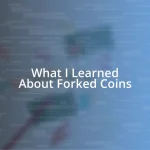Key takeaways:
- The evolution of token models has transitioned from basic utility tokens to advanced hybrid tokens that combine the features of both utility and security tokens.
- Hybrid tokens enhance user engagement in decentralized applications by rewarding participation while providing potential investment opportunities.
- Navigating the complexities of hybrid tokens involves balancing functionality and security, understanding regulatory environments, and utilizing robust user interfaces.

The Evolution of Token Models
Token models have come a long way since the inception of cryptocurrency, evolving from simple utility tokens to more complex structures like governance and hybrid tokens. I remember when I first dived into the world of tokens – the sheer variety was overwhelming, yet fascinating. It made me wonder, how could digital assets shift from mere transactional tools to integral components of a decentralized ecosystem?
As I explored the landscape, I noticed that hybrid tokens emerged as a response to the limitations of traditional models. They straddled the line between utility and security, which seemed revolutionary at the time. I found myself thinking: could these hybrid structures truly offer the best of both worlds, enabling flexibility while ensuring user trust and participation?
Reflecting on this journey, I can’t help but appreciate how these diverse token models mirror our own needs for both functionality and community engagement. It’s almost poetic how they evolve, adapting to the demands of the market and the aspirations of their users. Have you ever stopped to consider how much our digital interactions are shaped by these innovations?

Practical Applications of Hybrid Tokens
Another fascinating application of hybrid tokens is in the realm of crowdfunding. I recall participating in several initial coin offerings (ICOs) that promised potential rewards, but I always had that lingering fear of investing in something that could vanish overnight. With hybrid tokens, the model shifts significantly, blending aspects of utility. This allows backers to access early product features while keeping security standards high. It feels reassuring to know that I can engage with a project while mitigating risks.
Furthermore, hybrid tokens serve as powerful tools for incentivizing behavior in decentralized applications (dApps). When I embraced one such platform, I discovered how hybrid tokens could reward user interactions, driving engagement and loyalty. This dual functionality means users can both spend and hold, genuinely enhancing their overall experience. It’s almost like a win-win situation: I can actively participate while watching the value of my investment grow.
To illustrate some practical applications, here’s a comparison that highlights how hybrid tokens stack up against traditional token models.
| Aspect | Hybrid Tokens | Traditional Tokens |
|---|---|---|
| Utility | Offers functionality for users while serving as an investment | Primarily used for transactions with limited investment potential |
| Security | Combines the benefits of both utility and security tokens | Focused on either being a utility or a security without overlap |
| Engagement | Promotes active participation through rewards and incentives | Generally, passive interaction with limited user benefits |

Navigating Challenges with Hybrid Tokens
Navigating the world of hybrid tokens presents its own unique set of challenges. I’ve often found myself grappling with the balance between utility and security features in these tokens. It raises an important question: how do we ensure that hybrid models provide solid security while still delivering on the functionality users crave? There’s a sense of unease that comes with this dynamic, as too much focus on one aspect may lead to losing out on the benefits of the other.
One particular challenge I had to face was understanding the regulatory environment surrounding hybrid tokens. Regulations can be a maze, constantly shifting and often unclear. I distinctly remember feeling overwhelmed as I tried to keep up with updates, wondering if my investments were safe. This uncertainty emphasized for me how crucial it is to stay informed and adapt quickly. Have you ever felt that same pressure in the crypto space?
Additionally, I’ve encountered complexities in the actual usage of hybrid tokens within various platforms. I once took part in a decentralized application that seemed phenomenal but had quirky token mechanics. Imagine my surprise when the hybrid functionalities weren’t as seamless as I’d hoped! It was a learning curve that made me appreciate the importance of robust user interfaces that can support the diverse capabilities of hybrid tokens. From my experience, overcoming these challenges means engaging with communities, asking questions, and continuously learning. What strategies have you found helpful in navigating this evolving landscape?














